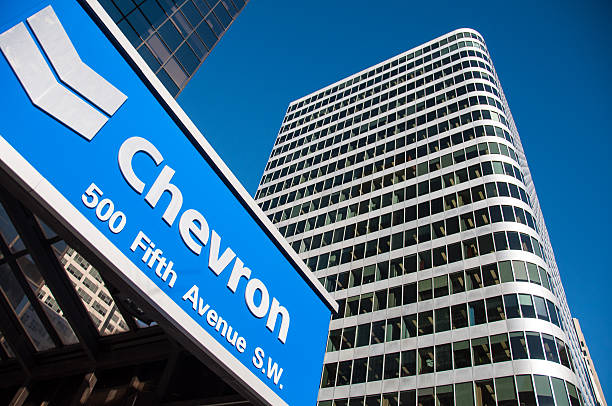Chevron Corporation, based in California, is a major global energy company with over a century of experience. It operates in all aspects of the oil and gas industry and is vital to meeting the world’s energy demands.
History and Foundation
Chevron’s origins date back to the 19th century, beginning with the formation of the Pacific Coast Oil Company in 1879. Over the years, Chevron evolved through mergers, acquisitions, and expansions. One of its significant milestones was the 1906 merger with Standard Oil, a key player in the oil industry. After the 1911 breakup of Standard Oil, Chevron emerged as a key player, initially known as Standard Oil of California. In 1984, it rebranded to Chevron Corporation post-merger with Gulf Oil, one of the era’s biggest mergers.
Business Operations
Chevron operates in over 180 countries, providing a wide range of products and services. The company’s operations can be broadly categorized into the upstream and downstream segments.
Upstream Segment
The upstream operations of Chevron involve the exploration, development, and production of crude oil and natural gas. Chevron globally explores and produces oil in regions rich in hydrocarbons including North America, West Africa, the Middle East, and Southeast Asia. They prioritize discovering new gas and oil sources, implementing technology to boost productivity and minimize environmental impact.
Chevron has a strong presence in the deepwater oil sector, with successful operations in areas like the Gulf of Mexico. The company also engages in shale oil and gas production, particularly in the Permian Basin, one of the richest oil fields in the United States.
Chevron is expanding into LNG projects alongside conventional oil and gas operations to meet the rising demand for cleaner energy. Notably, its Gorgon and Wheatstone projects in Australia rank among the world’s largest, strengthening Chevron’s presence in the natural gas sector.
Downstream Segment
Chevron’s downstream operations focus on refining crude oil into various products, such as gasoline, diesel, jet fuel, lubricants, and petrochemicals. The company operates a vast network of refineries and petrochemical facilities, where it processes millions of barrels of crude oil each day to meet the energy needs of consumers and industries.
Chevron also has an extensive marketing and distribution network. Its products are sold through Chevron and Texaco branded service stations worldwide. Additionally, Chevron is involved in the production and sale of petrochemical products used in manufacturing, agriculture, and construction.
Renewable Energy and Sustainability
As the global focus shifts toward cleaner energy sources and sustainability, Chevron has been adapting its strategy to incorporate renewable energy solutions. While the company remains heavily involved in fossil fuel production, it has made significant investments in developing low-carbon economy.
Chevron’s approach to the energy transition includes the development of carbon capture and storage (CCS) technologies, renewable fuels, and hydrogen. The company has invested in Chevron New Energies, an initiative to promote renewable energy solutions and achieve net-zero emissions by 2050.
Chevron is also focusing on reducing its methane emissions, improving energy efficiency across its operations, and utilizing solar and wind energy in some of its facilities. The company aims to play a leading role in the evolving energy landscape, balancing its traditional oil and gas activities with new, sustainable energy projects.
Financial Performance and Market Position
Chevron Corporation is one of the most financially robust companies in the Fenergy sector. With a market capitalization of over $300 billion as of 2023, Chevron ranks as one of the largest publicly traded energy companies. Its revenue comes from a diverse range of sources, including oil and gas production, refining, petrochemicals, and natural gas sales.
Also Read: Netflix Stock: Analyzing Its Growth in the Streaming Wars
Chevron’s financial strength comes from its diverse assets, enabling profit even in low oil price periods. With investments in high-margin oil projects, natural gas, and renewable energy, Chevron has a resilient business model to withstand global energy market fluctuations.
Chevron also maintains a strong commitment to returning value to shareholders. The company has consistently paid dividends, making it a popular choice among investors seeking stable returns in the energy sector.
Challenges and Future Outlook
Chevron, a leading energy company, faces challenges in the transition to cleaner energy globally. Adapting to reduced carbon emissions and changing markets requires navigating regulatory and environmental shifts.
One of Chevron’s challenges is balancing its commitment to oil and gas production with the increasing demand for renewable energy. While the company is investing in low-carbon solutions, it will need to accelerate its efforts to remain competitive in a rapidly evolving energy market.
Another challenge lies in geopolitical risks. Chevron operates in many regions with unstable political environments, where conflicts or sanctions can disrupt production and supply chains.
Looking ahead, Chevron’s focus on innovation and technology will play a critical role in its success. The company is developing advanced drilling technologies, AI-driven data analysis, and digital tools to improve operational efficiency and reduce costs. Chevron’s expertise in both renewable energy and oil/gas allows it to lead the energy transition effectively while still creating value for stakeholders.
Conclusion
Chevron Corporation remains a dominant force in the global energy industry, with a rich history, diverse operations, and a forward-looking strategy that integrates both traditional and renewable energy sources. Chevron is well-equipped to navigate the changing energy landscape with its oil and gas know-how, embracing cleaner energy solutions. Combining financial strength, tech innovation, and sustainability, Chevron remains pivotal in global energy supply.

